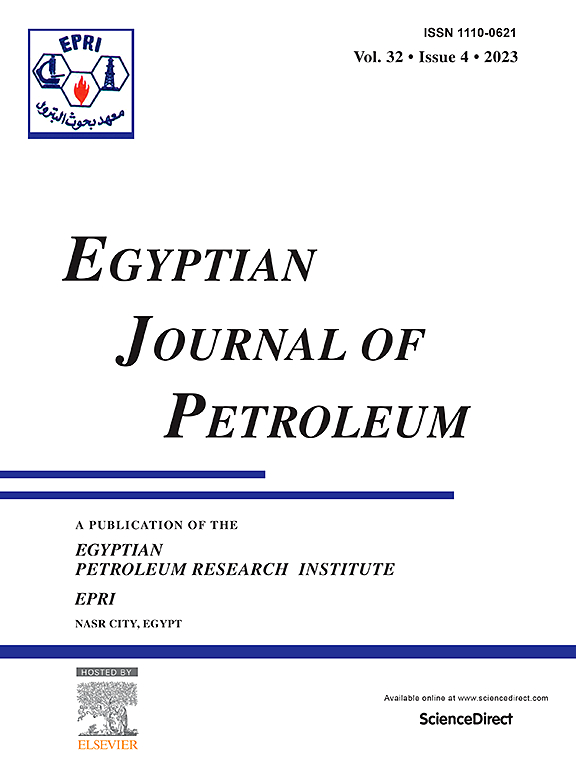埃及贝尼苏埃夫盆地阿扎尔油田白垩系储层碳氢化合物鉴定的岩石物理和气相色谱综合分析
Q1 Earth and Planetary Sciences
引用次数: 0
摘要
这项工作的目的是利用位于埃及西部沙漠贝尼苏伊夫盆地的 Azhar A-2 井和 Azhar E ¡ 1X 井的井记录数据和岩心数据,通过气相色谱分析,对白垩系晚期至新生代演替(上 Kharita 层、Bahariya 层和 Abu Roash ' G ' 成员)进行岩石物理评估。与 Azhar E ¡ 1X 井的上巴哈里亚地层相比,Azhar A-2 井的上巴哈里亚地层的石油净付层效果更好,厚度更小。两口井(Azhar A-2 井和 Azhar E¡ 1X 井)的气相色谱值分析很好地显示了碳氢化合物的类型。Abu Roash'G'成员的特征是其最下部存在石油,C 1 /C 2 比率也确定了石油的存在,其范围在 3 到 7 之间,其中 40 大于湿度比大于 17.5,特征比大于或等于 0.5,平衡比小于 17.5。在 A/R 的上部,"G "成员的特征是存在石油/重油,因为润湿比大于 40,特征比大于或等于 0.5,平衡比小于 17.5,C 1 /C 2 比值也表明存在石油/重油,其范围为 2 至 5。上巴哈利亚地层(Upper Bahariya Formation)的特点是存在石油/重油,其中润湿比大于 40,特征比大于或等于 0.5,平衡比小于 17.5,C 1 /C 2 比率也确定了石油和重油的存在,范围在 2 至 7.7 之间。对上哈里塔地层常规岩心数据的统计分析表明,上哈里塔地层的特点是孔隙度一般至良好,渗透率一般,其气相色谱值分析表明存在石油/重油,其中湿度比大于 40,特征比大于或等于 0.5,平衡比小于 17.5,C 1 /C 2 比值也表明存在石油/重油,其范围在 1.5 至 7 之间。本文章由计算机程序翻译,如有差异,请以英文原文为准。
Petrophysical and Gas Chromatographic Analysis Integration for Hydrocarbon Identifications in Cretaceous Reservoirs, Azhar Field, Beni Suef Basin, Egypt
The petrophysical assessment of the Cretaceous succession from late Albian to Cenomanian (Upper Kharita, Bahariya formations, and Abu Roash ‘ G ’ Member) con fi rmed by gas chromatographic analysis utilizing well-log data and core data from the Azhar A-2 and Azhar E ¡ 1X wells located within the Beni Suef Basin, Western Desert of Egypt, was the aim of this work. The oil net pay zone of the Upper Bahariya Formation in the Azhar A-2 well is more effective and has a lower thickness than that of the Upper Bahariya Formation in the Azhar E ¡ 1X well. The gas chromatographic value analysis of the two wells (Azhar A-2 and Azhar E ¡ 1X) gives a good signature about the type of hydrocarbon content. The Abu Roash ‘ G ’ Member is characterized by the presence of oil in its lowermost part, and the C 1 /C 2 ratio also con fi rmed the presence of oil, which ranges from 3 to 7, where 40 greater than wetness ratio greater than 17.5, character ratio greater than or equal to 0.5 with balance ratio less than 17.5. In the upper part of A/R, ‘ G ’ Member is characterized by the presence of oil/heavy oil because the wetness ratio is greater than 40 and the character ratio is greater than or equal to 0.5 with the balance ratio less than 17.5 and the C 1 /C 2 ratio also con fi rmed the presence of oil/heavy oil that ranged from 2 to 5. The Upper Bahariya Formation is characterized by the presence of oil/heavy oil, where the wetness ratio is greater than 40, character ratio is greater than or equal to 0.5 with the balance ratio less than 17.5, and the C 1 /C 2 ratio also con fi rmed the presence of oil and heavy oil, which ranges from 2 to 7.7. The statistical analysis of the Upper Kharita Formation conventional core data indicated that the Upper Kharita Formation is characterized by fair-to-good porosity, fair permeability, and its gas chromatographic value analysis shows the presence of oil/heavy oil, where the wetness ratio greater than 40, character ratio greater than or equal to 0.5 with balance ratio less than 17.5, and C 1 /C 2 ratio also con fi rmed the presence of oil/heavy oil, which ranged from 1.5 to 7.
求助全文
通过发布文献求助,成功后即可免费获取论文全文。
去求助
来源期刊

Egyptian Journal of Petroleum
Earth and Planetary Sciences-Geochemistry and Petrology
CiteScore
7.70
自引率
0.00%
发文量
29
审稿时长
84 days
期刊介绍:
Egyptian Journal of Petroleum is addressed to the fields of crude oil, natural gas, energy and related subjects. Its objective is to serve as a forum for research and development covering the following areas: • Sedimentation and petroleum exploration. • Production. • Analysis and testing. • Chemistry and technology of petroleum and natural gas. • Refining and processing. • Catalysis. • Applications and petrochemicals. It also publishes original research papers and reviews in areas relating to synthetic fuels and lubricants - pollution - corrosion - alternate sources of energy - gasification, liquefaction and geology of coal - tar sands and oil shale - biomass as a source of renewable energy. To meet with these requirements the Egyptian Journal of Petroleum welcomes manuscripts and review papers reporting on the state-of-the-art in the aforementioned topics. The Egyptian Journal of Petroleum is also willing to publish the proceedings of petroleum and energy related conferences in a single volume form.
 求助内容:
求助内容: 应助结果提醒方式:
应助结果提醒方式:


